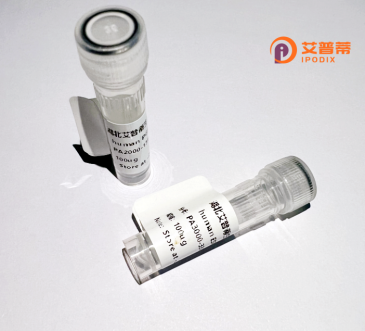
| 纯度 | >90%SDS-PAGE. |
| 种属 | Human |
| 靶点 | ARD1 |
| Uniprot No | Q12972 |
| 内毒素 | < 0.01EU/μg |
| 表达宿主 | E.coli |
| 表达区间 | 1-209aa |
| 氨基酸序列 | MGGEDDELKGLLGLPEEETELDNLTEFNTAHNKRISTLTIEEGNLDIQRPKRKRKNSRVTFSEDDEIINPEDVDPSVGRFRNMVQTAVVPVKKKRVEGPGSLGLEESGSRRMQNFAFSGGLYGGLPPTHSEAGSQPHGIHGTALIGGLPMPYPNLAPDVDLTPVVPSAVNMNPAPNPAVYNPEAVNEPKKKKYAKEAWPGKKPTPSLLILENGTHMASSDACHECKSMIAAAG |
| 分子量 | 52.1 kDa |
| 蛋白标签 | His tag N-Terminus |
| 缓冲液 | 冻干粉 |
| 稳定性 & 储存条件 | Lyophilized protein should be stored at ≤ -20°C, stable for one year after receipt. Reconstituted protein solution can be stored at 2-8°C for 2-7 days. Aliquots of reconstituted samples are stable at ≤ -20°C for 3 months. |
| 复溶 | Always centrifuge tubes before opening.Do not mix by vortex or pipetting. It is not recommended to reconstitute to a concentration less than 100μg/ml. Dissolve the lyophilized protein in distilled water. Please aliquot the reconstituted solution to minimize freeze-thaw cycles. |
以下是关于重组人ARD1蛋白的3篇参考文献概述:
---
1. **文献名称**: *ARD1-mediated Hsp70 acetylation balances stress-induced protein refolding and degradation*
**作者**: Jeong JW, et al.
**摘要**: 本研究揭示了ARD1通过乙酰化热休克蛋白Hsp70.调控应激条件下错误折叠蛋白的再折叠与降解过程。重组人ARD1蛋白实验证实其乙酰转移酶活性对细胞应对热休克和氧化损伤至关重要。
---
2. **文献名称**: *Structural and functional analysis of human ARD1-NAT complex in protein N-alpha-acetylation*
**作者**: Fisher TS, et al.
**摘要**: 该研究解析了重组人ARD1蛋白与NAT复合物的晶体结构,阐明了其在蛋白质N端乙酰化中的作用机制,并证明ARD1缺失导致细胞周期调控异常,提示其在癌症中的潜在作用。
---
3. **文献名称**: *Role of ARD1 in metabolic reprogramming via mTORC1 pathway modulation*
**作者**: Lee MN, et al.
**摘要**: 利用重组ARD1蛋白模型,作者发现ARD1通过乙酰化mTORC1复合物关键组分,抑制细胞糖酵解和脂质合成,揭示了其在代谢疾病与肿瘤中的治疗靶点潜力。
---
如需获取全文或更多文献,建议在PubMed或Web of Science中检索关键词“recombinant human ARD1”、“hARD1 protein”及相关功能研究。
ARD1 (Arrest-Defective-1), also known as N-acetyltransferase 1 (NAT1), is a conserved acetyltransferase enzyme encoded by the *NAA10* gene in humans. Initially identified in yeast for its role in cell cycle regulation, human ARD1 plays diverse roles in post-translational protein modification, primarily through N-terminal acetylation (Nt-acetylation), a common protein modification influencing stability, localization, and interactions. ARD1 exists as multiple isoforms (e.g., ARD1α and ARD1β) due to alternative splicing, with distinct functional properties. While ARD1α exhibits acetyltransferase activity, ARD1β lacks enzymatic function but may regulate cellular processes through protein interactions.
ARD1 interacts with hypoxia-inducible factor 1α (HIF-1α), acetylating it to promote degradation under normoxic conditions, thereby modulating oxygen-sensing pathways and angiogenesis. Dysregulation of ARD1 is implicated in cancer progression, metabolic disorders, and neurodegenerative diseases. Overexpression of ARD1 correlates with tumorigenesis in various cancers (e.g., breast, colorectal) by enhancing cell proliferation, survival, and metastasis. Conversely, reduced ARD1 activity is linked to developmental defects and mitochondrial dysfunction.
Recombinant human ARD1 protein is produced via bacterial (e.g., *E. coli*), insect, or mammalian expression systems for functional studies. Its structural analysis reveals a conserved GNAT (GCN5-related N-acetyltransferase) domain essential for catalytic activity. Research on ARD1 focuses on therapeutic targeting, particularly in oncology, aging, and metabolic diseases, leveraging its role in protein homeostasis and cellular signaling.
×